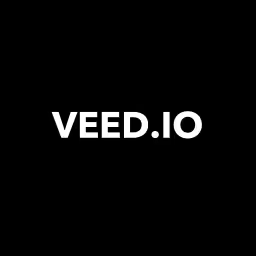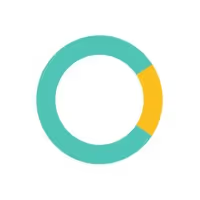Salesflare Alternatives
A direct comparison of 10 Salesflare alternatives. We analyze features, pricing, and use cases to help you find the best fit for your company.
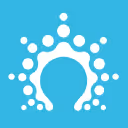
Salesflare is a popular CRM, especially for small to medium B2B companies. Many users like its automated data entry and simple visual pipeline. It's known for being easy to set up and use, which saves time on administrative tasks.
Still, like any tool, it has limits. Some users say its customization can be restricted or it might be missing advanced features. We've analyzed top alternatives based on G2 reviews to help you find the right fit. Let's get started.
11x: Digital Workers For Sales
For teams interested in digital workers, 11x provides autonomous agents for sales tasks. These agents can handle lead research and personalized outreach, which lets your sales team focus on other activities.
11x is a GTM platform that uses AI agents to manage the sales process. Its agent, Alice, finds prospects, handles outreach, and updates the CRM. Julian qualifies inbound leads and books meetings, replacing the need for separate data, outreach, and warmup tools.
Salesflare Alternatives
Here is a detailed look at the top Salesflare alternatives. Each review covers pricing, main features, and the specific benefits and potential drawbacks compared to Salesflare.
1) HubSpot CRM
HubSpot offers a comprehensive CRM platform that includes marketing, sales, and service hubs. Its free CRM is a popular entry point for many businesses. The platform is designed to be an all-in-one solution, which differs from Salesflare's specific focus on sales automation.
The main distinction is scope. HubSpot provides a wide range of tools, which can lead to a steeper learning curve and higher costs as you add features. Salesflare prioritizes simplicity and automated data entry for sales teams, making it faster to implement.
For companies that need an integrated system across marketing, sales, and customer service, HubSpot is a strong contender. It supports businesses that plan to scale their operations and consolidate their software stack. This is a key consideration for long-term growth.
However, if your primary need is a straightforward, sales-focused CRM with minimal setup, Salesflare remains a more direct option. Teams that want to avoid the complexity of a larger platform may find Salesflare's approach more suitable for their immediate goals.
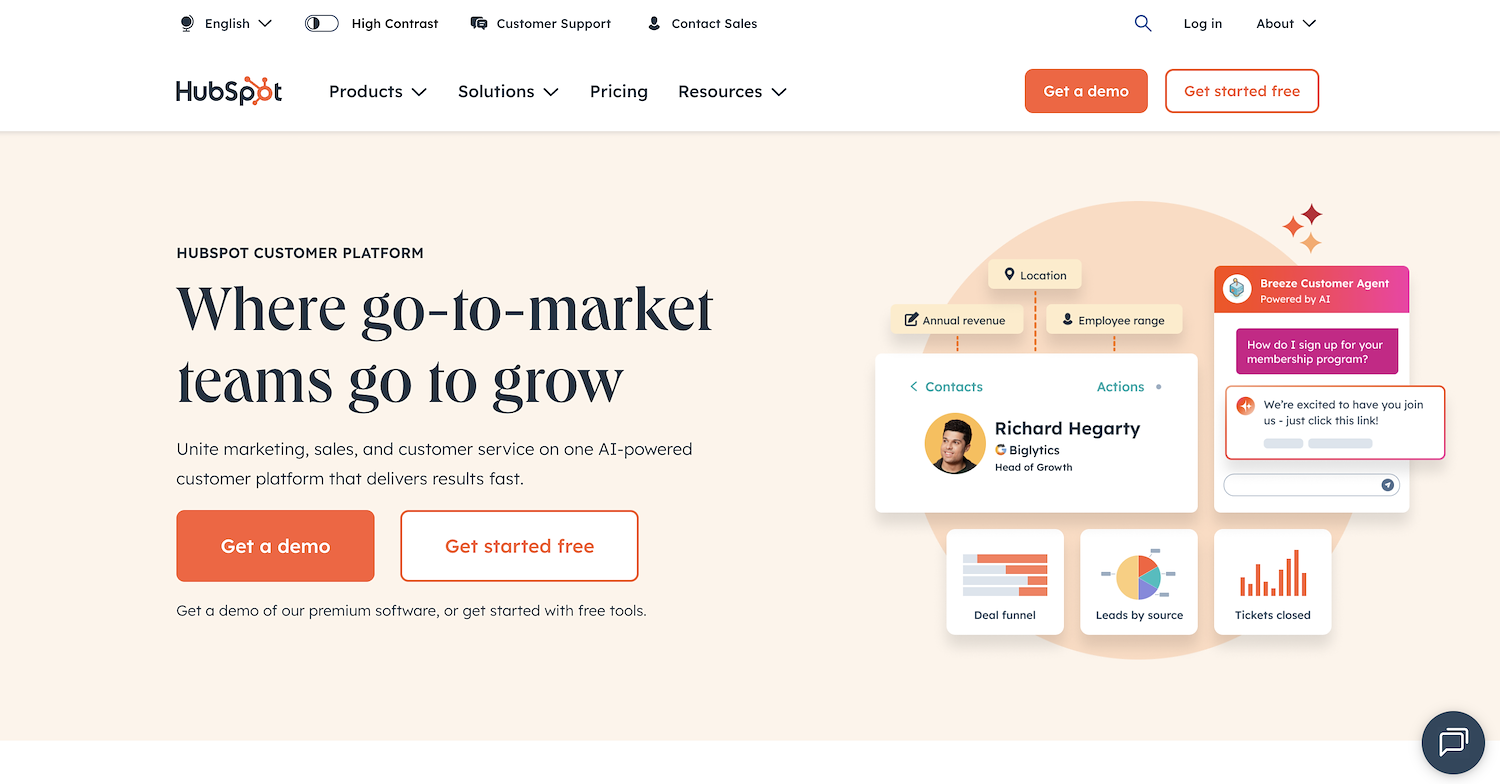
The HubSpot CRM platform combines marketing, sales, and service tools into one system. It functions as an all-in-one solution for businesses that want to consolidate their software. The free CRM offers a common entry point for companies.
The system supports businesses with plans for growth and a need for an integrated platform across multiple departments. This wide scope can mean a steeper learning curve for some teams.
HubSpot CRM's Main Features
Provides tools for lead generation, including integrated landing pages and forms.
Manages customer support through a shared inbox, ticketing system, and a self-service knowledge base.
Includes a content management system for building websites with a drag-and-drop editor and SEO tools.
HubSpot CRM vs. Salesflare: Key Differences
Average Review score: 4.4/5 stars based on 12,407 G2 reviews.
HubSpot provides marketing automation tools like email campaigns. This differs from Salesflare, which centers on sales tasks and needs other tools for broad marketing efforts.
It has built-in customer support tools, including case management. This is a contrast to Salesflare, where the focus remains strictly on the sales process.
The platform combines sales, marketing, and service into one system. Salesflare, in comparison, is a dedicated CRM built just for sales teams.
This tool offers native features for lead generation, like forms and landing pages. This is different from Salesflare, which focuses on pulling contact data from emails and social profiles.
Where HubSpot CRM Falls Short Compared to Salesflare
HubSpot CRM combines sales, marketing, and service tools, which can make it complex for teams that only need a sales solution. Salesflare provides a simpler, more focused sales platform that is often quicker to adopt.
Some users find data entry in HubSpot can be more manual compared to Salesflare. Salesflare automatically populates the CRM with contact details from emails and social profiles, reducing administrative work for the sales team.
The platform's costs can increase significantly when you need features from higher-tier plans or add more users. This is different from Salesflare, which offers a more straightforward pricing model centered on its core sales automation features.
Pricing and Cost-Effectiveness
HubSpot provides a free CRM and a lower-cost entry point with its Starter plan at $20 per seat, while Salesflare's Growth plan starts at $29 per user. For more advanced features, Salesflare's Pro ($49) and Enterprise ($99) plans are more budget-friendly than HubSpot's Professional ($100) and Enterprise ($150) equivalents.
2) Pipedrive
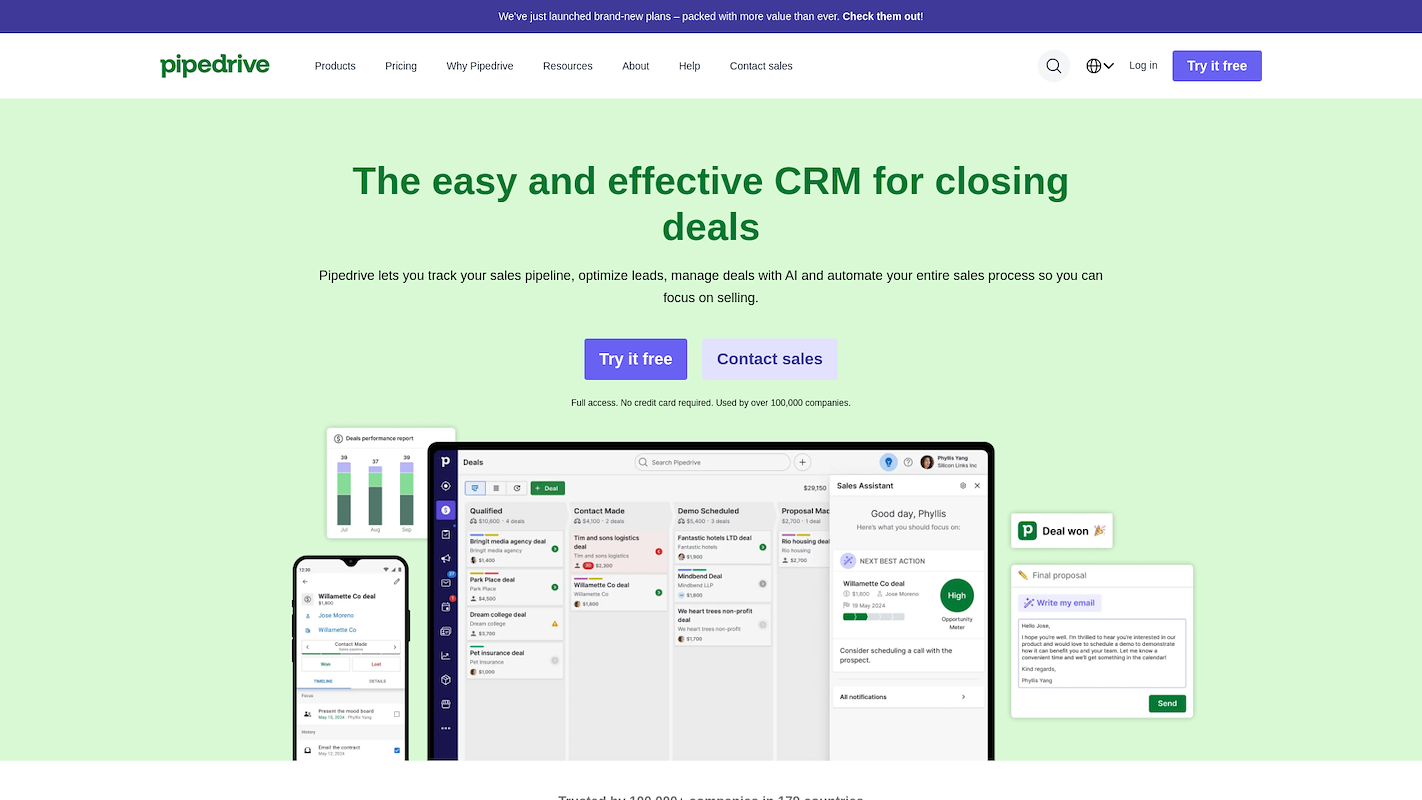
Pipedrive is a web-based CRM for sales teams to track pipelines, manage deals, and automate work. It uses a visual, kanban-style pipeline and provides workflow automation. The platform centralizes customer data and communications in one place.
AI offers insights to prioritize deals, and the system generates real-time sales forecasts. Pipedrive serves over 100,000 companies and offers a 14-day free trial.
Pipedrive's Main Features
Offers a visual, kanban-style pipeline with custom stages and drag-and-drop deal management.
Includes an AI Sales Assistant that provides deal-win predictions and daily insights.
Automates multi-step email sequences and provides two-way email sync with templates and tracking.
Generates real-time dashboards and revenue forecasts for both recurring and one-off deals.
Pipedrive Vs. Salesflare: Key Differences
Average Review score: 4.3/5 stars based on 2,573 G2 reviews.
Pipedrive provides a highly customizable visual pipeline with user-defined stages. This offers more granular control over the sales process compared to Salesflare's simpler pipeline structure.
The tool includes built-in features for marketing automation and email campaigns. Salesflare, in contrast, centers on sales tasks and typically requires third-party tools for broad marketing efforts.
It has an AI Sales Assistant that gives tips and predicts the likelihood of winning a deal. This is different from Salesflare's AI, which focuses on automatically gathering contact information.
The platform includes a separate lead inbox to qualify prospects before they enter the sales pipeline. Salesflare's approach integrates new contacts directly into the deal flow from sources like emails.
Where Pipedrive Falls Short Compared to Salesflare
Pipedrive may require more manual data entry to keep contact information current. Salesflare, in comparison, automatically finds and updates contact details from emails and social profiles, which reduces administrative work.
Some users report that Pipedrive's email sync can be inconsistent, and it is not available on the lowest-priced plan. Salesflare provides deep email integration to automatically log communications as a core part of its platform.
The platform separates lead qualification into a distinct inbox before a deal enters the pipeline. This can add a step for teams that prefer Salesflare's simpler approach, where new contacts from emails are integrated directly into the workflow.
Pricing and Cost-Effectiveness
Pipedrive offers a lower entry point with its Lite plan at $24 per user, while Salesflare's Growth plan starts at $29. Their mid-range plans are priced similarly, with Pipedrive's Growth and Salesflare's Pro both at $49, and both tools offer an enterprise-level plan at $99 per user. For the most current details, visit Pipedrive's official website.
3) Zoho CRM

Zoho CRM is a cloud-based platform that helps organizations convert more leads and build lasting relationships. It supports cross-functional collaboration, which allows different departments to work from shared data while using separate workspaces. The system provides a 360-degree view of every customer.
AI assistance handles tasks like email rewrites and pipeline health predictions. The platform, available since 2005, has a privacy-first culture.
Zoho CRM's Main Features
Provides dedicated workspaces that allow different departments to use shared data within separate, collaborative areas.
Includes a drag-and-drop UI customizer, the Canvas Design Studio, for changing the platform's layout without code.
Supports real-time customer engagement across multiple channels, including web, phone, email, and social media.
Uses an AI assistant for tasks such as email rewriting, anomaly detection, and generating predictive insights.
Zoho CRM Vs. Salesflare: Key Differences
Average Review score: 4.1/5 stars based on 2,820 G2 reviews.
Zoho CRM offers built-in tools for marketing, sales, and customer support in one platform. This is different from Salesflare, which focuses on sales automation and requires separate tools for marketing or service tasks.
The platform includes a drag-and-drop editor to customize the user interface. This provides more layout flexibility compared to Salesflare, where customization options can be more limited.
Its AI assistant provides predictive sales insights and detects pipeline anomalies. This is different from Salesflare's AI, which automates contact data entry from emails and social media.
This tool provides native customer support features like case management and a knowledge base. Salesflare does not include these and is built as a dedicated CRM for sales teams.
Where Zoho CRM Falls Short Compared to Salesflare
Some users find the initial setup for Zoho CRM can be complex because of its many features. Salesflare, in contrast, is built for a quicker implementation, which helps teams that prioritize a fast start.
The tool's automation focuses on internal workflows, which sometimes means users must manually log external communications. Salesflare is different because it automatically captures interactions from email and calendars, creating a hands-off activity timeline.
Its interface can sometimes feel cluttered to users due to the high number of features available. Teams that prefer a minimalist design may find Salesflare's clean layout, which centers on the sales pipeline, easier to navigate.
Pricing and Cost-Effectiveness
Zoho CRM is more budget-friendly, with a free plan and paid tiers starting at $14 per user, compared to Salesflare's entry plan at $29. Its Enterprise plan at $40 is also significantly lower than Salesflare's $99 equivalent. For detailed pricing, visit Zoho CRM's official website.
4) Salesforce Sales Cloud
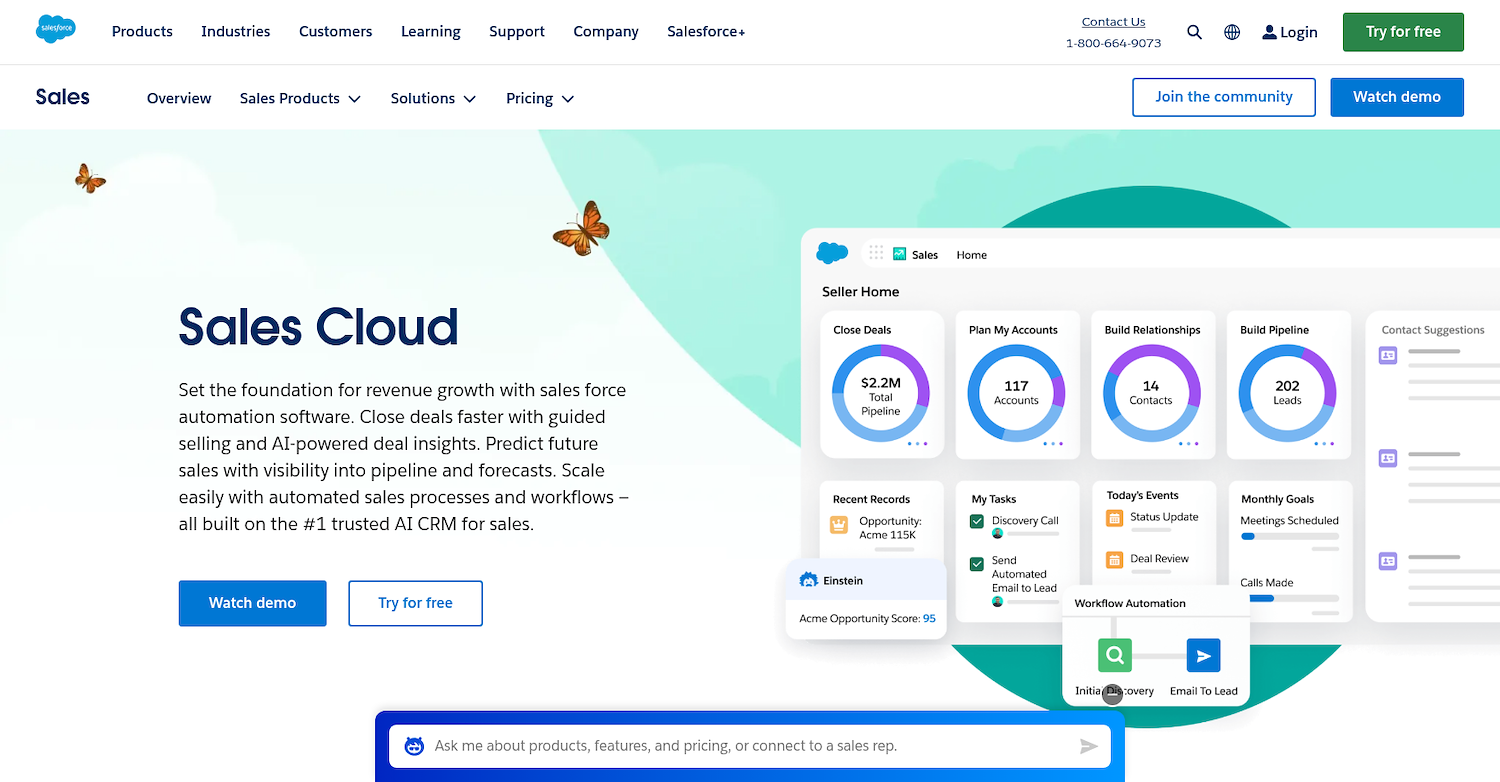
Salesforce Sales Cloud is a CRM platform built for sales teams. It uses data and AI to help sellers connect with customers and automates processes to free up time for sales work. The system includes tools to manage the entire sales pipeline.
It also provides functions for sales forecasts and reports to support decisions. The platform is designed to help companies close more deals and accelerate growth.
Salesforce Sales Cloud's Main Features
Automates complex processes and territory assignments using a drag-and-drop flow builder.
Generates templated quotes that sync to opportunities and manages automated approval flows.
Offers deal-specific guidance and account planning tools to manage opportunities.
Provides a consolidated pipeline view with change-over-time charts and AI-powered deal insights.
Salesforce Sales Cloud Vs. Salesflare: Key Differences
Average Review score: 4.4/5 stars based on 23,364 G2 reviews.
Salesforce Sales Cloud offers built-in marketing and customer support modules. This contrasts with Salesflare, which is a dedicated sales tool and needs integrations for those functions.
It provides a drag-and-drop flow builder for creating complex process automations. This allows for more detailed workflow customization compared to Salesflare's automated data entry.
The platform includes features for quote generation and automated approval management. Salesflare does not have these native tools and focuses on pipeline and contact management.
This tool has a dedicated module for Partner Relationship Management (PRM) to manage channel sales. This is a function not found in Salesflare, which is built for direct sales teams.
Where Salesforce Sales Cloud Falls Short
Salesforce Sales Cloud can have a steep learning curve due to its extensive features, which may require dedicated training. In contrast, Salesflare offers a more straightforward user experience that allows teams to get started with less initial setup and instruction.
Some users report that keeping the CRM updated in Salesforce requires manual data entry. Salesflare is different because it automatically populates contact and company information from emails and social profiles, which saves time on administrative tasks.
The tool's total cost can increase substantially with more users or when advanced features are needed from higher-tier plans. Salesflare generally presents a more affordable option, especially for smaller teams that do not need the vast scope of an enterprise-level platform.
Pricing and Cost-Effectiveness
Salesforce Sales Cloud's Starter plan is $25 per user, slightly less than Salesflare's $29 Growth plan. However, Salesflare's Pro ($49) and Enterprise ($99) plans are more budget-friendly than Salesforce's Professional ($100) and Enterprise ($165) tiers, offering a cost-effective path for scaling.
5) Freshsales

Freshsales is a sales-focused CRM that unifies customer context in one place. It equips sales teams with tools to manage leads, contacts, and deals throughout the sales pipeline, from initial capture to final closure.
Freshsales's Main Features
Uses AI to run campaigns and to capture, qualify, route, and track leads.
Engages prospects on their preferred channels with full context and intent scoring.
Provides AI-driven deal recommendations, highlights opportunities, and identifies pipeline bottlenecks.
Includes an AI assistant that drafts emails and offers always-on guidance.
Freshsales Vs. Salesflare: Key Differences
Average Review score: 4.5/5 stars based on 1,224 G2 reviews.
Freshsales includes native customer support features like case management. This is different from Salesflare, which is a dedicated sales CRM and requires other tools for support functions.
The platform provides built-in marketing automation for running email campaigns. In contrast, Salesflare centers on sales tasks and needs third-party integrations for broader marketing activities.
Its AI assistant offers actionable deal insights and helps draft sales emails. This differs from Salesflare's AI, which focuses on automating contact data entry from emails and social profiles.
This tool offers built-in phone and chat capabilities for direct prospect engagement. Salesflare integrates deeply with email and calendars but does not have native phone or chat functions.
Where Freshsales Falls Short Compared to Salesflare
Freshsales sometimes requires more manual data entry to keep contact information current. In comparison, Salesflare automatically finds and updates contact details from emails and social profiles, which can reduce administrative work for the sales team.
The tool's all-in-one approach combines sales, marketing, and support, which might be complex for teams that only need a sales CRM. Salesflare provides a more focused platform built just for sales teams, which can be simpler to adopt and use.
Its activity tracking can be less automatic for some users. Salesflare, on the other hand, automatically logs all email and calendar interactions, creating a complete activity timeline without requiring manual input from the sales representative.
Pricing and Cost-Effectiveness
Freshsales offers a more budget-friendly entry point with its Growth plan at $9 per user, compared to Salesflare's $29. This cost advantage continues across its Pro ($39 vs. $49) and Enterprise ($59 vs. $99) tiers, making it a more economical option at every level.
Try 11x for Autonomous Sales Agents
For a different approach to sales automation, consider 11x. Their autonomous agents handle lead research and outreach, which frees your sales staff to focus on deals. You can explore how these digital workers support your sales operations on their website.
With 11x, we use AI to run your sales playbook. Alice finds accounts, enriches their data, and manages outreach. Julian qualifies inbound leads and schedules meetings. Our platform replaces separate data, outreach, and warmup tools, consolidating your GTM stack.
Book a demo to see it in action.
6) Copper
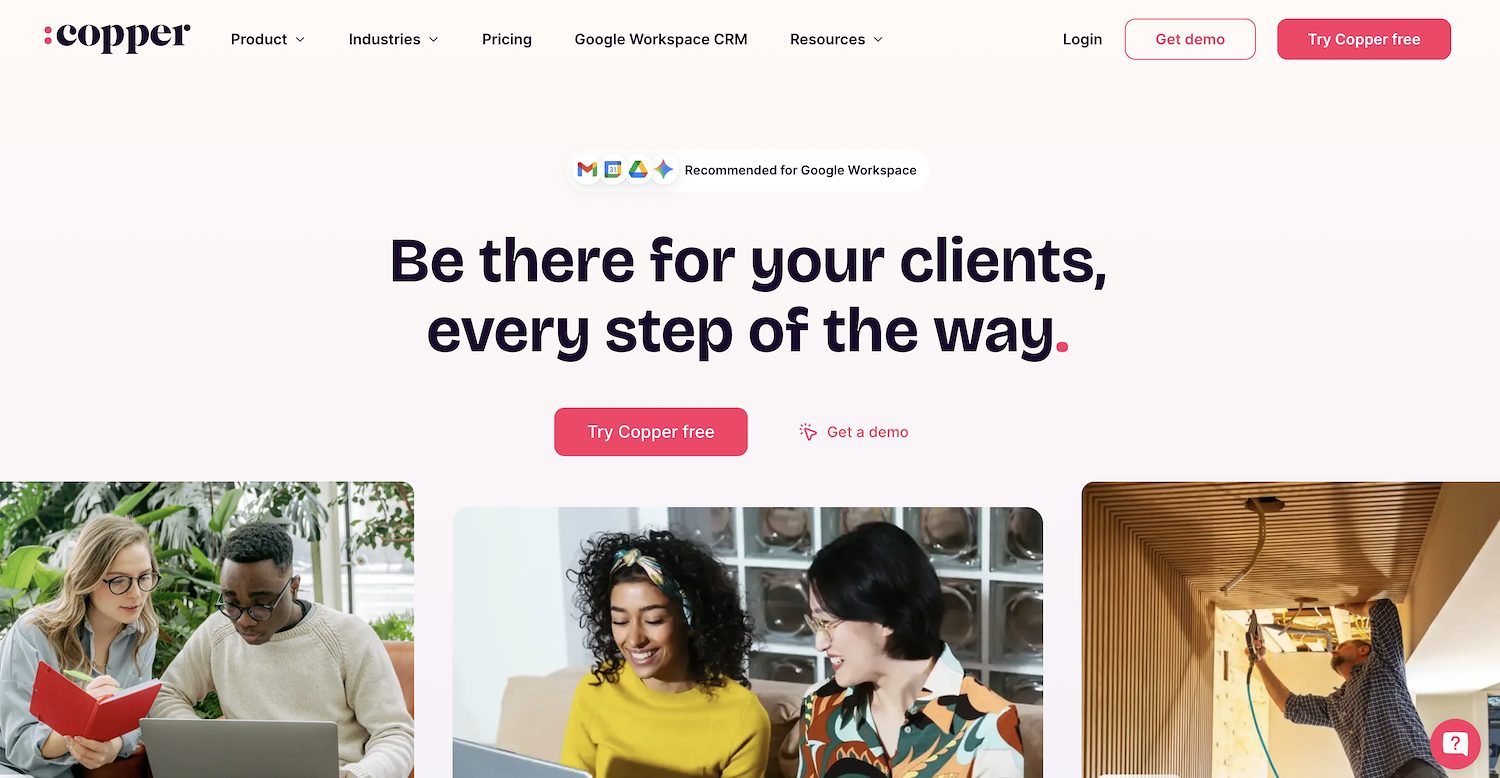
Copper is a CRM platform for sales teams. The system helps users manage contacts, deals, and communication in one location. It provides a structure for the sales process. Businesses evaluate it when they search for an alternative to their current sales software.
Copper's Main Features
Integrates with Google Workspace to manage leads, emails, and tasks from within Gmail or Google Calendar.
Provides customizable, drag-and-drop pipelines to track deals with probability weighting and value sorting.
Manages projects by converting closed deals into project boards for task assignment and team collaboration.
Automates email with personalized series and triggers messages based on the deal's pipeline stage.
Copper Vs. Salesflare: Key Differences
Average Review score: 4.5/5 stars based on 1,139 G2 reviews.
Copper integrates directly into Google Workspace, which lets users manage contacts and tasks from inside Gmail. This is different from Salesflare, which syncs with email but works as a separate application.
It includes project management features that convert closed deals into project boards. This supports post-sale workflows, a function not found in Salesflare's sales-focused platform.
The tool offers lead capture through website forms and a business card scanner. Salesflare, in comparison, automates data entry by pulling information from email signatures and social profiles.
This platform connects directly with Google Sheets and Looker Studio for custom reporting. This provides more flexible data analysis options compared to the built-in reports in Salesflare.
Where Copper Falls Short Compared to Salesflare
Salesflare automatically enriches contacts with data from social media and public company databases. Copper relies more on information within Google Workspace, which sometimes means contact profiles are less complete than those in Salesflare.
The tool's design centers on Google Workspace. This creates a challenge for teams that use other systems like Microsoft Outlook. Salesflare, as a separate application, offers a consistent experience regardless of a team's email provider.
Some users find that automatic activity logging is less complete for communications outside of Gmail. Salesflare, by comparison, tracks all interactions from any linked email account, which builds a more comprehensive activity history without manual work.
Pricing and Cost-Effectiveness
Copper's pricing starts lower, with a Basic plan at $23 per user versus Salesflare's Growth plan at $29. For mid-tier needs, Salesflare's Pro plan ($49) is more budget-friendly than Copper's Professional option ($59). Both tools align at the enterprise level with plans priced at $99 per user.
7) monday sales CRM

monday sales CRM is a platform built on the monday.com Work OS. It helps teams manage the full sales cycle in one workspace. The system allows users to customize workflows, dashboards, and data fields to fit specific business processes and centralize customer information.
monday sales CRM's Main Features
Manages the entire customer journey, from pre-sales lead capture to post-sales account management, in one place.
Offers no-code customization for editing deal stages, adding data columns, and creating multiple sales pipelines.
Provides AI assistants that generate tasks from meeting notes, compose emails, and build reports using natural language.
Automates repetitive tasks like lead assignment, setting activity reminders, and sending notifications when emails are opened.
monday sales CRM Vs. Salesflare: Key Differences
Average Review score: 4.6/5 stars based on 973 G2 reviews.
monday sales CRM provides no-code tools to fully customize pipelines and data fields. This offers more control over the sales process compared to Salesflare's simpler structure.
It manages the entire customer lifecycle, including post-sales activities like onboarding. This is a broader scope than Salesflare, which concentrates on the pre-sale stages of the pipeline.
The platform's AI assistant helps with tasks like composing emails and building reports. This is different from Salesflare's AI, which focuses on automatically gathering contact data.
This tool is part of the larger monday.com Work OS, which connects sales to other business processes. Salesflare, in contrast, is a standalone application built specifically for sales teams.
Where monday sales CRM Falls Short
monday sales CRM sometimes requires more manual data entry to keep contacts updated. Salesflare is different; it automatically finds and populates contact information from email signatures and social media to reduce administrative tasks.
Its automatic activity logging can be less comprehensive for communications outside of the platform. In comparison, Salesflare automatically tracks every email and meeting from a connected inbox to build a complete interaction history without manual input.
The tool's high level of customization can make the initial setup complex for teams that want a simple sales solution. Salesflare offers a more focused experience and a simpler structure for a quicker start with less configuration.
Pricing and Cost-Effectiveness
monday sales CRM is more budget-friendly, with plans starting at $12 per user, while Salesflare's entry plan is $29. This cost difference is also notable at the mid-tier, where monday's Pro plan is $28, compared to Salesflare's Pro plan at $49.
8) Insightly CRM

Insightly CRM is a unified platform for businesses to manage customer relationships across departments. It centralizes data to give sales, marketing, and service teams a shared view of every customer interaction. This helps align company-wide efforts from one source of truth.
The system is built to map the customer journey. It allows teams to track contacts from the first touchpoint to post-sale projects, supporting companies that want to build consistent customer experiences.
Insightly CRM's Main Features
Manages products, price books, and quotes to generate custom proposals directly from opportunities.
Offers companion products for marketing automation and customer service within the same platform.
Provides a mobile app for Android and iOS with a business card scanner for contact creation.
Includes customer support tools such as case management and a knowledge base.
Insightly CRM Vs. Salesflare: Key Differences
Average Review score: 4.2/5 stars based on 922 G2 reviews.
Insightly CRM includes tools to manage products and generate quotes directly from opportunities. This is a feature not present in Salesflare, which focuses more on pipeline management.
It offers companion products for marketing and customer service on the same platform. This provides a more unified system than Salesflare, which requires separate tools for those functions.
The platform's mobile app includes a business card scanner for quick contact creation. This offers a different method for lead capture compared to Salesflare's automated data entry from email signatures.
This tool allows for more extensive customization with custom objects and apps. This gives more flexibility to tailor workflows than Salesflare's simpler, more structured approach.
Where Insightly CRM Falls Short
Insightly CRM often requires manual data entry to keep contact profiles complete. In comparison, Salesflare automatically enriches contacts with data from social media and public databases. This process saves time and creates more detailed records for the sales team.
The platform's automatic activity logging can sometimes be less complete for communications outside of the system. Salesflare is different because it tracks all interactions from any linked email account. This builds a more comprehensive activity history without manual work from the user.
Some users note that the tool limits bulk emails to 50 contacts at once. This can be a drawback for teams that run larger outreach campaigns. Salesflare's email integration is built for sales communication and does not have this specific limitation.
Pricing and Cost-Effectiveness
Insightly CRM and Salesflare have identical pricing structures across their main plans. Both tools offer entry-level tiers at $29, professional plans at $49, and enterprise options at $99 per user monthly. The decision comes down to which platform's features provide better value for your specific needs at each price point.
9) Close
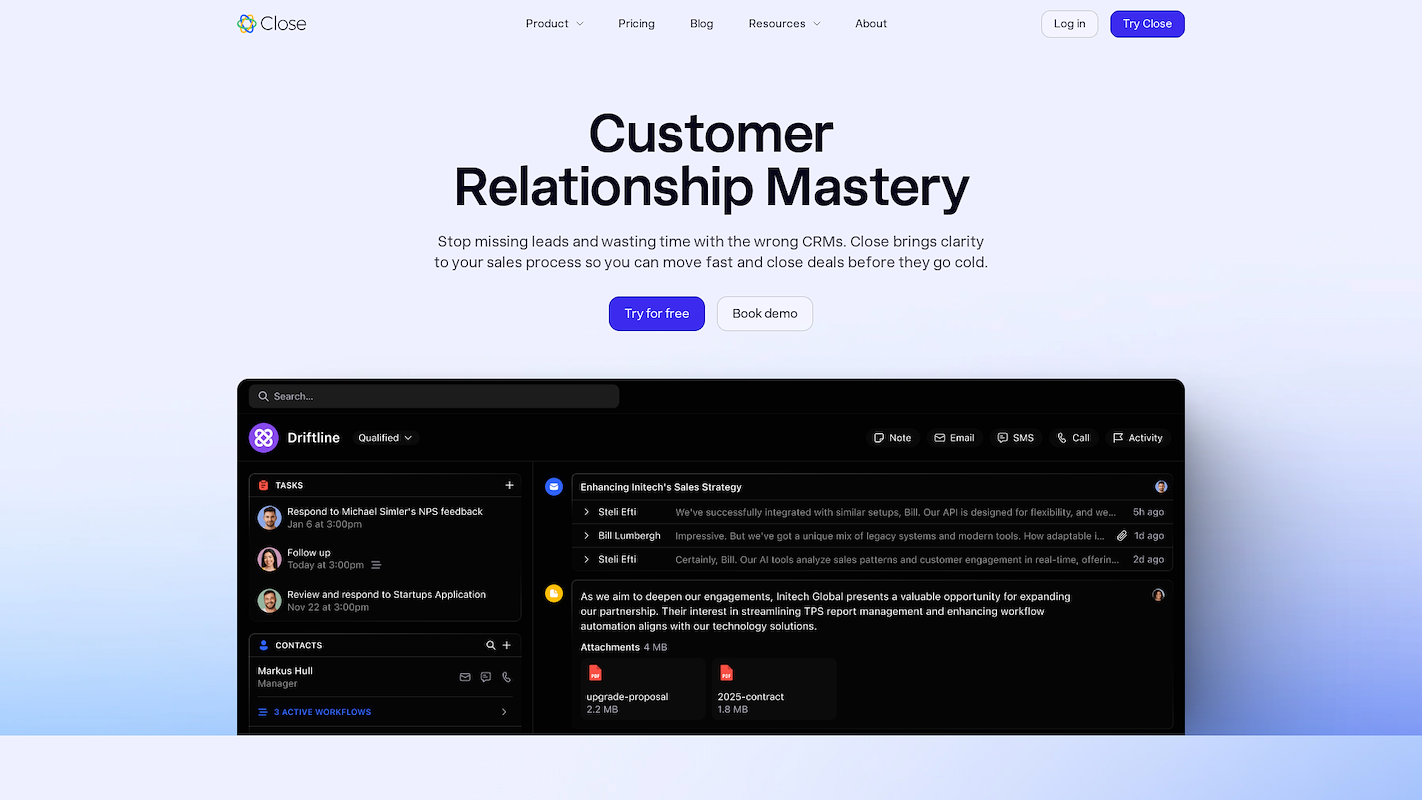
Close is a sales CRM that puts all communication channels in one place. It combines email, phone calls, and SMS to help sales teams work more efficiently. The platform is built for inside and remote sales teams that need to manage a high volume of leads and conversations.
Close's Main Features
Combines email, SMS, and a built-in phone dialer into a single unified inbox for all communications.
Includes marketing automation tools for managing email campaigns and tracking lead engagement.
Provides customer support features, including case management and a knowledge base, within the platform.
Close Vs. Salesflare: Key Differences
Average Review score: 4.7/5 stars based on 1,812 G2 reviews.
Close combines email, SMS, and a built-in phone dialer into a single inbox. This is different from Salesflare, which syncs with email and calendars but does not have native phone or SMS functions.
The platform includes marketing automation tools for managing email campaigns. In contrast, Salesflare centers on sales tasks and needs third-party integrations for broad marketing activities.
It provides customer support features such as case management. This function is not native to Salesflare, which is built as a dedicated CRM for sales teams.
This tool offers a built-in power dialer to make calls directly from the CRM. Salesflare does not have this feature and instead focuses on tracking communications from external sources like email.
Where Close Falls Short Compared to Salesflare
Some users note that Close requires manual effort to keep contact records complete. This differs from Salesflare, which automatically enriches profiles with data from social media and company databases to save time.
The platform is built around high-volume outreach with its integrated dialer and SMS. For teams that do not need these communication tools, Salesflare provides a more direct focus on pipeline management and automated relationship tracking.
Its activity tracking works best for communications made inside the platform. Salesflare offers a different approach; it automatically logs all interactions from a user's connected email and calendar and creates a timeline without manual effort.
Pricing and Cost-Effectiveness
Close offers a lower entry point with its Solo plan at $9 per user, while its Essentials plan ($35) is more expensive than Salesflare's Growth plan ($29). Salesflare's Pro plan ($49) is more affordable than Close's Growth plan ($99), though both platforms offer a tier at the $99 price point.
10) Nutshell
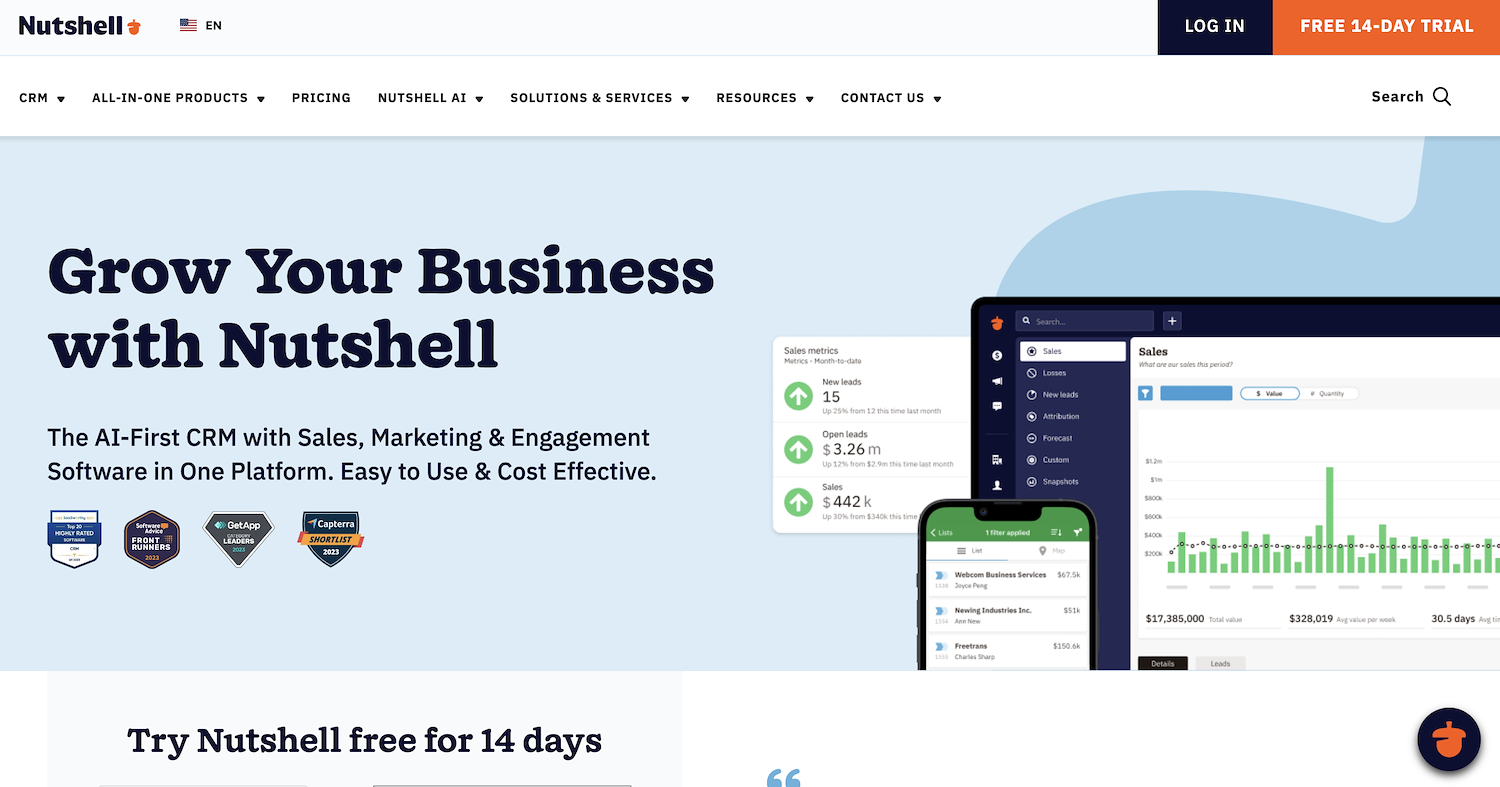
Nutshell is a CRM and email marketing platform for B2B companies. It provides sales and marketing teams with a single application to manage pipelines and automate outreach. The system centralizes contact data, sales activities, and email campaigns to help teams collaborate and win more deals.
Nutshell's Main Features
Provides email marketing and automation tools to manage campaigns.
Includes customer support features with a dedicated portal and a knowledge base.
Controls platform access with user, role, and access management settings.
Nutshell Vs. Salesflare: Key Differences
Average Review score: 4.3/5 stars based on 1,273 G2 reviews.
Nutshell provides built-in email marketing tools to create campaigns and landing pages. This differs from Salesflare, which focuses on sales tasks and requires other tools for marketing.
It includes native customer support features like a knowledge base and a customer portal. Salesflare, in contrast, is a dedicated sales CRM and does not have these support functions.
The platform offers native web chat and text messaging to engage with leads directly. This provides more communication channels compared to Salesflare, which centers on email and calendar integration.
This tool provides free data migration assistance with every subscription. This can be a notable benefit for teams that move from another system, a service not highlighted for Salesflare.
Where Nutshell Falls Short Compared to Salesflare
Nutshell sometimes requires more manual work to keep contact information complete. In comparison, Salesflare automatically finds and adds contact details from email signatures and social media, which reduces data entry for the sales team.
The tool's automatic activity logging can be less complete for communications outside of the platform. Salesflare, by contrast, tracks every interaction from a connected email account and calendar and builds a full history without manual effort.
Its all-in-one approach combines sales and marketing tools, which can be complex for teams that only need a sales CRM. Salesflare offers a more focused platform built just for sales, which can be simpler to set up and use.
Pricing and Cost-Effectiveness
Nutshell is more budget-friendly across the board, with its entry-level plan starting at $13 per user compared to Salesflare's $29. This price advantage continues up the tiers, with Nutshell's Pro plan at $42 versus Salesflare's Pro plan at $49.
Which One Should You Go With?
The right Salesflare alternative depends on your company's specific needs, from team size to existing software. This guide reviewed several options to help you find a suitable platform for your sales process.
For a different approach, consider 11x. Its autonomous agents automate sales tasks like lead research and outreach. This frees your sales team to focus on conversations with prospects and can replace several tools in your GTM stack.



